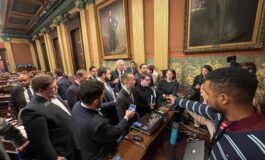DETROIT — Detroit enters 2014 in bankruptcy, the largest public case in U.S. history and facing $18 billion or more in debt. Yet the Motor City’s resurgent auto industry is strong enough to host a show that by one estimate will generate nearly $400 million for the area’s economy.
The industrial city is looking to climb out from under decades of financial decline as its longtime industry revs ahead four years after two of its major players, General Motors and Chrysler, emerged from bankruptcies of their own.
Also brining more positive light to the auto industry is the projected 8 percent increase over last year for Detroit’s local economy. David Sowerby, a chief marketing anylist for Loomis Sayles & Co. told the AP that there were several factors behind the increase.
“Economic activity is strong, the industry itself is stronger, there’s a modest increase in new models and if you talk to hotel or lodging industry, the number of conferences is growing as is business activity and travel.”
Sowerby’s analysis doesn’t seem to be an exaggeration. On Friday, January 10, Downtown hotels reported that occupancy was 85 percent on average during the auto show press days that were scheduled on Monday and Tuesday. The hotels are also reporting a 70 percent occupancy from Jan 18 through Jan. 26, the days the show is open to the public.
Local restaurants and bars should be packed with the estimated 5,000 journalists and 800,000 visitors expected at the show. Overall, the show provides a pick-me-up for the area, illustrated by amped-up coverage from local television stations and highway billboards welcoming visitors and industry types.

All three Detroit automakers have made billions in the recovery following the Great Recession. Ford expects to post an $8.5 billion profit before taxes for 2013, while GM grossed $4.8 billion pretax through the first nine months of 2013. Chrysler is still the smallest and least profitable of the three, but made $1.4 billion in pretaxes through the 3rd quarter. It is safe to say that all three major companies have been able to make a turn-around since 2009, when auto sales hit a low of 10.4 million cars. Last year that number reached 15.6 million.
The automakers’ show displays and parties were more Spartan affairs in the dark days of 2010. This year, exhibits in particular are as lavish as ever, with two-story buildings inside the Cobo Center.
Sowerby, who crunches the numbers for the show organizer, the Detroit Auto Dealers Association, estimates the event’s economic impact at as much as $390 million to the Detroit area, which also includes some thriving suburbs and its Canadian neighbor across the river, Windsor, Ontario.
By comparison, a study performed by an outside research firm for the Detroit Metro Convention & Visitors Bureau in 2006 put the impact of that year’s Super Bowl XL at about $275 million, including pass-along, or spinoff spending by the merchants and others.
It appears to be clear why the auto show would have a more beneficial impact on the local economy that the super bowl would. The Super Bowl represents about a week of events and “overhyped parties” leading up to and including the game itself, whereas the auto show represents several weeks that includes construction of exhibits, press previews, the eight-day public show itself and the teardown.
This year the auto show will have more than 500 vehicles on display and more than 50 new model introductions.
Sowerby says it’s difficult to tease out the specific benefits to the city of Detroit itself beyond the boost to its downtown elevated rail system and businesses, such as hotels, bars and restaurants, and the prestige of a marquee event at a city-owned convention facility. There’s no local sales tax, nor does Detroit levy one on hotels or motels.
Officials say the city doesn’t bear additional costs for public safety, since show officials handle their own security. Likewise, Sowerby believes that the host city’s major-league financial woes won’t hamper the show.
“I don’t think that the bankruptcy factored into it,” he says. “Is it going to deter somebody’s desire to attend the auto this year? … The extent that Detroit rises to the occasion (says) that bankruptcy doesn’t mean ‘closed to business.'”
Even more than a mile down the river from Cobo Center, Andrews on the Corner owner Tom Woolsey says he gets extra business during the auto show. He’s noticed a “remarkable” turnaround at his restaurant-bar since about mid-2012, as automakers have recovered, events have grown along a more pedestrian-friendly riverfront and people even started moving downtown.
“The economy isn’t what they expected it to be but it’s up and moving in the right direction,” says Woolsey, whose grandfather opened Andrews in 1918. “The city, I think, is going to do much better now that it’s hit bottom.”






Leave a Reply